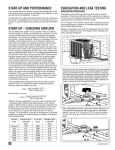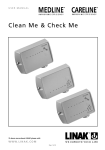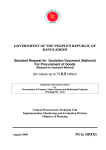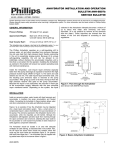Download SRH3 - In Duct Diagnostic Psychrometer
Transcript
Fieldpiece Quick Start In-Duct Problem-Solving Psychrometer OPERATOR'S MANUAL Model SRH3 80 Certifications PRESS FOR 1 SECOND AUTO-OFF ON/OFF RH/DP/WB BATTERY CHECK PRESS 1 SEC TO CLEAR UNITS MAX/MIN/H ENTER OUTPUT Description 1. Power on your SRH3 by holding the ON/OFF button for 1 second. 2. Use the TSH/TEET/NORM button to select NORMAL mode. 3. Press the RH/DP/WB button to cycle between relative humidity, dew point, and wet bulb temperatures. 4. The air temperature will always be shown in the lower display and the relative humidity, dew point, or wet bulb measurement will be displayed in the upper display in real-time. 5. Insert sensor probe into duct for in-duct measurements. C-Tick (N22675) CE TSH/TEET/NORM In-Duct Diagnostic Psychrometer WEEE RoHS Compliant SRH3 01 02 plenum placement of probe. Insert SRH3 probe into the plenum to take the wet bulb measurement. Press ENTER to lock in the reading. 3. Take a dry bulb (air temperature) measurement going into the condensor. Press ENTER to lock in the reading. 4. Press OUTPUT to calculate the target superheat. Compare the target superheat to the actual superheat of the system. 5. Seal any holes before leaving the jobsite. How to Use Normal Mode Normal mode allows you quickly and easily take real-time dry bulb, wet bulb, dew point, and relative humidity measurements. 1. Press TSH/TEET/NORM button until NORM is displayed in lower left corner. 2. For upper display measurements, press the RH/DP/ WB button to toggle relative humidity, dew point, or wet bulb temperature measurements. Note: Dry bulb (air temperature) will always show in the lower display. Perform a simple Target Superheat test to determine what the superheat should be on a fixed restrictor system. Use the target superheat to compare to the actual superheat to determine if a system is properly charged. 07 08 1. Press the TSH/TEET/NORM button until TEET is displayed in the lower left of the LCD. 2. Take a wet bulb measurement inside the return plenum. Drill or punch a 3/8" hole into the return plenum. See Figure 1 for recommended return plenum placement of probe. Insert SRH3 probe into the plenum to take the wet bulb measurement. Press ENTER to lock in the reading. 1. Press the backlight button to toggle the backlight on/off at any time during the SRH3's use. Note: The back light will automatically shut off after 1 minute to conserve battery life. Maximum/Minimum/Hold 1. Pressing the MAX/MIN/H button activates the Max-Min-Hold function, holding the maximum and minimum measured values until cleared. 2. Once the Max-Min-Hold function has been enabled, pressing MAX/MIN/H cycles between displaying maximum (MAX), minimum (MIN) and freezing the current value. 80 3. Press and hold the MAX/MIN/H button for 2 seconds to erases all stored maximum and minimum values and return to real-time measurements. BATTERY CHECK PRESS 1 SEC TO CLEAR Units 1. Press the units button to switch between degrees Fahrenheit and Celsius. Battery Check 1. Press and hold the UNIT button for 2 seconds to 80 80display the battery life in percentage. 80 Output 1. Press the OUTPUT button to perform calculations of Target Superheat and Target Evaporator Exit Temperature after necessary measurements have been entered. ON/OFF 04 HOLD HOLD AVERAGE AVERAGE UNITS UNITS Use the RCONE1 to lock your sensor probe in place inside the duct. Using the RCONE1 and magnet on the SRH3 DUCT allows you hands-free in-duct testing. See Figure 2. DUCT WARNING Do not retract the sensor probe by pulling on the cord. Doing so may sever the cord from the sensors. 09 Backlight Toggle Backlight. (Hold while powering 80 your SRH3 on to disable APO.) Auto Power Off Enabled Low Battery Indicator Relative Humidity Dew Point Wet Bulb Toggles to display Maximum, Minimum, Dry Bulb MAX/MIN/ H or Hold the current reading. Hold for 1 %Relative Humidity second to exit and clear stored values. Outdoor ENTER Confirm Selection Indoor Target Superheat Outputs calculations for Target Target Evaporator Exit Tem- Superheat or Target Evaporator Exit OUTPUT perature Temperature Normal Range Toggle to80 enter Target Superheat, Temperature (Fahrenheit) PRESS FOR TSH/TEET/NORM Target Evaporator Exit Temp, or AUTO-OFF Temperature (Celsius) 1 SECOND Normal modes. 80 Hold Display Maximum Display Minimum Display ON/OFF RCONE1 Probe Lock Functions Toggle display to show relative RH/DP/WB humidiy, dew point and wet bulb temperatures Toggle between Fahrenheit and Celcius. Hold for 2 seconds to display battery UNITS percentage. ON/OFF Target Evaporator Exit Temperature ( TEET ), aka temperature drop or delta T, is used to determine if the evaporator is getting the optimum airflow. A TEET test can be quickly per formed by taking two easy temperature measurements at the return side of the evaporator. Controls ON/OFF Hold 1 second to toggle power on/off. 3. Take a dry bulb measurement at the same place the previous wet bulb measurement was taken. Press PRESS FOR ENTER to lock in the reading. AUTO-OFF 1 SECOND 4. Press OUTPUT to calculate the target evaporator exit FOR PRESS AUTO-OFF temperature. Compare this calculated target to1theSECOND actual evaporator exit temperature. 5. Take a dry bulb measurement inside the supply plenum to check the actual Evaporator Exit Temperature. See Figure 1 for recommended supply plenum placement of probe. Drill or punch a 3/8" hole into the supply plenum. Press TSH/TEET/NORM RECORDSRH3 MODE until NORM is displayed.Insert probe into MODE the plenum and read RECORD the temperature in the lower display. 6. Seal any holes before leaving the jobsite. Note: For both Target Superheat and Target Evaporator Exit Temperature modes, you can adjust any temperature measurement after calculations have been performed by pressing ENTER. This prompts you to re-take the measurements. Target Evaporator Exit Temperature Mode Target Superheat Mode 1. Press TSH/TEET/NORM button until TSH is displayed in the lower left of the LCD. 2. Take a wet bulb measurement at the inlet of the evaporator. Generally right before the filter is a good location. Drill or punch a 3/8" hole into the return plenum for a measurment depth of up to 24 inches. See Figure 1 for recommended return 03 Display With your purchase of the SRH3 you now have the ability to take supply/ return temperature, %RH, wet bulb and dew point measurements from inside the duct or plenum. Your SRH3 is a portable, hand held, diagnostic psychrometer, designed for the HVAC/R technician. SRH3 helps you properly charge a fixed restrictor system by quickly determining the Target Superheat ( TSH). Your SRH3 can also help determine optimum airflow across the evaporator by easily performing a Target Evaporator Exit Temperature (TEET) test. The 38"(96cm) telescoping probe with laser etched ruling and flattened edges allows you to locate proper measurement points within a duct and ensures that your probe is properly aligned. The dual display with a bright backlight, rugged rubber boot with probe clips, make sure the SRH3 is ready for any job. ENTER10 ENTER 05 PRESS FOR PRESS FOR PRESS FOR 1 SECOND SECOND 11 SECOND RECORD MODE AUTO-OFF AUTO-OFF AUTO-OFF Figure 1 ON/OFF ON/OFF ON/OFF HOLD AVERAGE RECORD MODE RECORD MODE Recommended Hole Placement for Supply Plenum Measurements HOLD HOLD AVERAGE AVERAGE 06 Specifications Relative Humidity: Telescoping Probe Length: Up to 38 inches (97cm) Probe Tip Diameter: 0.35 inch (9mm) Storage temperature: -4°F to 140°F (-20°C to 60°C), 0 to 80% RH (with battery removed) Temperature Coefficient: 0.1 x (specified accuracy)/°C (<18°C or >28°C) Over range: "OL" or "-OL" is displayed Power: Single standard 9-volt battery, NEDA 1604, JIS 006P, IEC 6F22 UNITS Auto Power off: after 15 minutes of inactivity if APO is active. Battery life: 150 hours typical (alkaline) Low Battery Indication: is displayed when the battery voltage drops below the operating level. Dimensions: 7.9 in (H) x 2.6 in (W) x 1.4 in (D), [200mm (H) x 66mm (W) x 36mm (D)] Weight: Approx. 400g, including battery Sensor Type: Capacitance polymer film Operating environment: 32°F to 131°F (0°C to 55°C) Range: 0% to 100%RH Accuracy: ±(2.5%) 10% to 90%RH ±(5%) <10%RH and >90%RH Note: Above accuracies stated at 73.4°F (23°C). Sensor Response Time: 60 seconds typical for 90% of total range. Sensor Hystersis: ±1%RH typical (Excursion of 10% to 90% to 10%RH) Figure 2 DUCT UNITS UNITS UNITS DUCT DUCT DUCT Temperature: ENTERSensor type: Precision thermistor ENTER ENTER ENTER Operating environment: -4°F to 140°F (-20°C to 60°C) Range: -4°F to 140°F (-20°C to 60°C) Resolution: 0.1°F / 0.1°C Accuracy: ±(1°F) 32°F to 113°F ±(2°F) -4°F to 32°F, 113°F to 140°F ±(0.5°C) 0°C to 45°C ±(1°C) -20°C to 0°C, 45°C to 60°C Recommended Hole Placement for CLEAR DATA CLEAR Return Plenum CLEARDATA DATA CLEAR DATA Measurement is directly before the evaporator coil. Look behind the panel before drilling and make sure you do NOT drill a hole through any critical HVAC components. MAX/MIN MAX/MIN MAX/MIN MAX/MIN 11 AUTO-OFF PRESS FOR 1 SECOND ON/OFF RH/DP/WB BATTERY CHECK Use the RCONE1 for hands-free in-duct measuremesnts. 12 PRESS 1 SEC TO CLEAR UNITS MAX/MIN/H ENTER OUTPUT TSH/TEET/NORM In-Duct Diagnostic Psychrometer SRH3 A/C Basics Low Pre ssu r THROTTLE VALVE ide eS I n t h e U S A , c a l l Fi e l d p i e c e Instruments for one-price-fix-all out of warranty service pricing. Send check or money order for the amount quoted. Send the meter freight prepaid to Fieldpiece Instruments. Send proof of date and location of purchase for in-warranty service. The meter will be repaired or replaced, at the option of Fieldpiece, and returned via least cost transportation. Outside of the USA, please visit www.fieldpiece.com for service contact information. REFRIGERANT FLOW Pr COMPRESSOR es sure Side OUTDOOR AIR HOT AIR CONDENSER 15 16 Wireless Solutions from Fieldpiece ET2W with ARH4 ET2W with ACH4 CLAMP CAT.III AC Current Clamp AC Cur rent Clamp ET2W w/ ARH4 transmitting wirelessly to EH4W ! 1AAC / 1mVAC 400AAC MAX 1AAC / 1mVA C 400AAC MAX ACH4 ACH4 ET2W AUTO OFF ET2W AUTO OFF SEND Wireless Transmitter RECEIVE SEND ET2W AC DC SYNC ON SEND Wireless Transmitter SYNC LO BATT RECEIVE TO CONNECT ONLY HEAD! ACCESSORY ON Wireless Transmitter PRESS FOR INPUT FORM SET 01 Set ID:Indoor Temp 72.8 Measurement: SET 02 SET ID:Comp Amps 23.6 Measurement: CustomerID:__JONES123 RECEIVE DC Wireless Transmitter CheckMe! SYNC RECEIVE Combustion AC Cle SEND ONLY ar CAL Service Light Combustion Cle ar LO BATT Subcooling Recall FUSED ve Sa 15 SEC FOR 500mV RANGE CAT.III MAX 600V FUSED 200mA MAX ve Recall Sa LT17AW w/ Built-in Wireless Fieldpiece HG3 21 22 23 24 Enter Units T1 T2 Direct Fieldpiece HG3 Superheat Target Superheat Alarm 30V MAX Subcooling Superheat Subcooling T2 ON/OFF Refrigerant HVAC Guide Display Data Logger APO AUTO OFF Display EH4W CheckMe! °F°C SCT2 LSAT ODDB HH:MM:SS Digital Manifold + Vacuum Gauge T1 SETUP CFM °F°C SHT1 VSAT IDWB °F°C RMicrons Target SH StableSet Alarm HiLo Enter Target Evaporator Exit Temp Psig Kpa inHg cmHg Saturation CAL CAL Atmospheric Pressure Test Pressure ON Wireless Transmitter Superheat HVAC Guide 20 Psig Kpa inHg cmHg 50 5000m 500m 500µ 50m 200m 500 750 500 1400 200m 2K 200 20 20M 2K 200K 200 SETUP AC DC SEND Service Light 1 SEC TO EXIT 600500 500µ 50m Data Logger LO BATT HOLD 500600 RECV LO BATT Target Evaporator Exit Temp Output Sync Enter CFM SYNC Input 50 5000m 500m ET2W ON WIRELESS ENABLED SYNC ON LO BATT AUTO-OFF www.fieldpiece.com AUTO-OFF MAX/MIN AC DC SEND SMAN3 is the most advanced digital manifold w/ micron gauge on the market. Check it out. SMAN3 Wireless Transmitter RECEIVE ET2W MAX 30VDC 24VAC 18 SMAN3 Digital Manifold w/ Micron Gauge Output Sync LO BATT AC DC HG3 Multi-Channel Wireless Receiver data logging multiple readings at the same time 17 INPUT FORM SET 01 Set ID:Indoor Temp Measurement: 72.8 SET 02 SET ID:Comp Amps Measurement: 23.6 CustomerID:__JONES123 ON ET2W SEND Your SRH3 powers off automatically after approximately 15 minutes to lengthen battery life. To disable "Auto Off," hold the button while powering on your SRH3. When disabled, APO will not display in upper left of LCD. ! Input ARH4 SYNC Auto Power Off AC DC AC DC ARH4 SYNC 19 300V 400A ET2W with ACM3 This meter is warranted against defects in material or workmanship for one year from date of purchase. Fieldpiece will replace or repair the defective unit, at its option, subject to verification of the defect. This warranty does not apply to defects resulting from abuse, neglect, accident, unauthorized repair, alteration, or unreasonable use of the instrument. Any implied warranties arising from the sale of a Fieldpiece product, including but not limited to implied warranties of merchantability and fitness for a particular purpose, are limited to the above. Fieldpiece shall not be liable for loss of use of the instrument or other incidental or consequential damages, expenses, or economic loss, or for any claim of such damage, expenses, or economic loss. S t a te l aws v a r y. Th e a b ove limitations or exclusions may not apply to you. HG3 w/ MultiChannel Wireless CLAMP 300V 400A CAT.III RECEIVE © Fieldpiece Instruments, Inc 2011; v05 Sensor Care When not in use it is best to protect this sensors with the vinyl slip cover included with the SRH3. Extreme conditions or exposure to solvent vapors may offset the RH% sensor. If this happens, place the sensor in a controlled envrionment of 75%RH and between 68°F - 86°F for a period of 24 hours. To create a 75%RH environment moisten a small amout of table salt, in an open container such as a clean 2 liter bottle cap. Place the container with the salt solution and the SRH3 probe in a sealable plastic bag, and leave the bag in a room temperature location where it will not be disturbed for 24 hours. Note: It is important that the salt solution does not come in direct contact with the sensor, as this may permenantly damage the sensor. Limited Warranty the meter displays the battery should be replaced. Turn your SRH3 off and replace with 9V battery. Clean the exterior with a dry cloth. Do not use liquid. SUPPLY AIR h For Service 14 The highly superheated gas enters the condenser and rejects heat into the outside air. The refrigerant RETURN AIR Battery ReplacementWhen Maintenance EVAPORATOR Hig 13 Th e Eva p o rato r, Co n d e n s e r, Restrictor ( Throttling valve) and Compressor are the four basic components of an air conditioner. Following one pound of refrigerant through the system shows the function of each component. Subcooled liquid refrigerant at high pressure enters the restrictor and is throttled to saturated refrigerant at a lower pressure. The restrictor can be of either a fixed or TXV/EXV type. The fixed type must be charged to a target superheat that varies with indoor and outdoor conditions. TXV/EXV systems must be charged to subcooling. The evaporator capacity varies with the indoor heat load on a fixed restrictor. The TXV/EXV regulates the size of the restriction to maintain a constant superheat. This essentially adjusts the capacity of the evaporator responding to the indoor heat load. After the restrictor, refrigerant enters the evaporator at a low temperature and pressure and boils (evaporates) condenses back into a liquid. Once all of the gas is condensed into a liquid, additional removal of heat causes a temperature drop that is known as subcooling. TXV/EXV systems are charged to subcooling since superheat is controlled by the throttle valve. Subcooling measurements are taken on the liquid line between the condenser and TXV/EXV. Finally, the subcooled liquid enters the restrictor and the cycle starts again. into a gas by absorbing heat from the indoor air. The refrigerant stays at the same temperature and pressure until all the refrigerant evaporates into a gas. After the refrigerant becomes a gas, it will continue to absorb heat and become superheated at which point its temperature will change. The Superheat measurement is the best indication of refrigerant charge level in a fixed restrictor system. A TXV/ EXV system will keep the superheat constant. There must be superheat present to ensure liquid does not flood the compressor. Superheat measurements are taken on the suction line between the evaporator and compressor. The compressor takes this low temperature, low pressure, slightly superheated refrigerant and compresses it to a much higher temperature and pressure. CAL


















